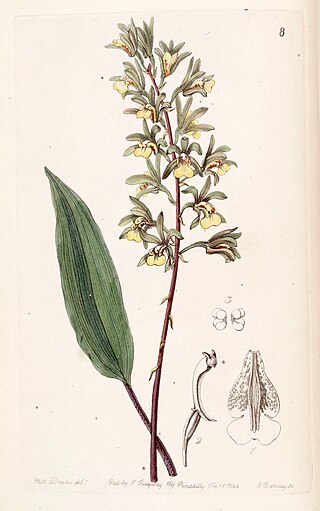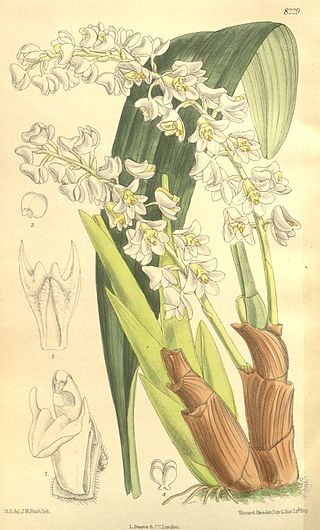
Tainia, commonly known as ribbon orchids or 带唇兰属 is a genus of about thirty species of evergreen, terrestrial orchids in the distributed from India, China, Japan, Southeast Asia to New Guinea, the Solomon Islands and Queensland.

Corybas, commonly known as helmet orchids, is a genus of about 120 species of plants in the orchid family, Orchidaceae. Helmet orchids are small, perennial, deciduous herbs and are nearly always terrestrial. They have a single leaf at their base and a single flower on a short stalk, the flower dominated by its large dorsal sepal and labellum. Species of Corybas are found in Australia, New Zealand, New Guinea, Southeast Asia, the Himalayas, southern China, many Pacific islands and a few sub-Antarctic islands.

Acriopsis, commonly known as chandelier orchids or 合萼兰属 is a genus of flowering plants in the family Orchidaceaes. Orchids in this genus are epiphytic herbs with spherical or cylindrical pseudobulbs, creeping, branched rhizomes, thin white roots, two or three leaves and many small flowers. The flowers are non-resupinate with the lateral sepals joined along their edges and have spreading petals and a three-lobed labellum. The column has projections that extend hood-like beyond the anther.

Gastrodia, commonly known as potato orchids, is a genus of terrestrial leafless orchids in the family Orchidaceae, about ninety of which have been described. Orchids in this genus have fleshy, upright stems and small to medium-sized resupinate flowers with narrow sepals and petals. They are native to Asia, Australia, New Zealand, central Africa, and various islands of the Indian and Pacific Oceans.

Bryobium, commonly known as urchin orchids or 藓兰属 , is a genus of flowering plants in the family Orchidaceae. Orchids in this genus are epiphytic or lithophytic plants with large, fleshy pseudobulbs, each with up to three leathery leaves and small, often hairy flowers. These orchids are found from tropical Asia to northern Australia.

Pinalia, commonly known as gremlin orchids, is a genus of flowering plants in the family Orchidaceae. Orchids in this genus are large epiphytic or lithophytic plants with prominent pseudobulbs, each with up to three thin, flat leaves and cup-shaped, relatively short-lived flowers with scale-like brown hairs on the outside. There are about 120 species occurring from tropical to subtropical Asia to the south-west Pacific.

Trichoglottis, commonly known as cherub orchids or 毛舌兰属 , is a genus of flowering plants in the family Orchidaceae. Orchids in this genus are epiphytic plants with thick roots, relatively thick, fibrous stems and many large, thick, leathery leaves arranged in two ranks. The flowers are usually small and yellowish with light brown or purple markings. The flowers have broad sepals, narrower petals and a labellum which has three lobes and is often hairy. There are about 85 species distributed from tropical and subtropical Asia to the north-western Pacific. Most species grow in rainforest.

Dipodium punctatum, commonly known as the blotched hyacinth-orchid, is a leafless orchid that is a native to eastern and south-eastern continental Australia. In summer it produces a tall flowering stem with up to sixty pale to bright pink flowers with heavy red blotches. A widespread and common species it is often confused with D. roseum and some authorities regard it as a synonym of D. squamatum.

Pholidota, commonly known as rattlesnake orchids, is a genus of flowering plants from the orchid family, Orchidaceae. Plants in this genus are clump-forming epiphytes or lithophytes with pseudobulbs, each with a single large leaf and a large number of small, whitish flowers arranged in two ranks along a thin, wiry flowering stem that emerges from the top of the pseudobulb. There are about thirty five species native to areas from tropical and subtropical Asia to the southwestern Pacific.

Dipodium roseum, commonly known as rosy hyacinth-orchid or pink hyacinth-orchid, is a leafless saprophytic orchid found in east and south-eastern Australia. In summer it produces a tall flowering stem with up to fifty pale pink flowers with small, dark red spots. A widespread and common species it is often confused with D. punctatum but has darker, less heavily spotted flowers.

Cryptostylis, commonly known as tongue orchids, is a genus of flowering plants from the orchid family. Tongue orchids are terrestrial herbs with one to a few stalked leaves at the base of the flowering stem, or leafless. One to a few dull coloured flowers are borne on an erect flowering stem. The most conspicuous part of the flower is the labellum, compared to the much reduced sepals and petals. At least some species are pollinated by wasps when they attempt to mate with the flower. There are about twenty five species found in South Asia, Southeast Asia and the South Pacific.
Erythrodes is a genus of flowering plants from the orchid family, Orchidaceae. It contains 26 currently recognised species, native to Southeast Asia, China, the Indian Subcontinent, New Guinea, and some islands of the Pacific.
- Erythrodes amboinensis(J.J.Sm.) J.J.Sm. - Ambon
- Erythrodes bicalcarata(R.S.Rogers & C.T.White) W.Kittr. - New Guinea
- Erythrodes bicarinataSchltr. - New Guinea, Vanuatu
- Erythrodes blumei(Lindl.) Schltr. in K.M.Schumann & C.A.G.Lauterbach - from Assam east to Taiwan, south to Java
- Erythrodes boettcheriAmes - Luzon
- Erythrodes celebensisP.O'Byrne - Sulawesi
- Erythrodes forcipataSchltr. - New Guinea
- Erythrodes glandulosa(Lindl.) Ames - Borneo
- Erythrodes glaucescensSchltr. - New Guinea
- Erythrodes hirsuta(Griff.) Ormerod in G.Seidenfaden - Hainan, Assam, Bhutan, Myanmar, Thailand, Vietnam
- Erythrodes humilis(Blume) J.J.Sm. - Java, Sumatra, peninsular Malaysia
- Erythrodes johorensis(P.O'Byrne) Ormerod - peninsular Malaysia
- Erythrodes latifoliaBlume - Java, Sumatra, peninsular Malaysia
- Erythrodes latilobaOrmerod - Sri Lanka
- Erythrodes oxyglossaSchltr. - Fiji, New Caledonia, Samoa, Tonga, Vanuatu, Wallis & Futuna
- Erythrodes papuanaSchltr. in K.M.Schumann & C.A.G.Lauterbach - New Guinea
- Erythrodes parvulaKores - Fiji, Tonga
- Erythrodes praemorsaSchltr. - New Guinea
- Erythrodes purpurascensSchltr. in K.M.Schumann & C.A.G.Lauterbach - New Guinea, Fiji, Tonga, Samoa
- Erythrodes sepikanaSchltr. - New Guinea
- Erythrodes sutricalcarL.O.Williams - New Guinea
- Erythrodes tetrodontaOrmerod - New Guinea
- Erythrodes torricellensisSchltr. - New Guinea
- Erythrodes trilobaCarr - Sabah
- Erythrodes weberiAmes - Philippines
- Erythrodes wenzeliiAmes - Philippines

Vrydagzynea, commonly called tonsil orchids, is a genus of orchids in the tribe Cranichideae. About forty five species of Vrydagzynea have been formally described. They are native to India, Taiwan, Southeast Asia, Malesia, Melanesia and Polynesia. A single species in Australia is possibly extinct. They have thinly textured, stalked leaves and small, dull-coloured resupinate flowers with the dorsal sepal and petals overlapping to form a hood over the column.

Thelasis, commonly known as fly orchids, is a genus of flowering plants from the orchid family, Orchidaceae. Plants in this genus are usually epiphytes, sometimes lithophytes or rarely terrestrials. Some species have pseudobulbs with up to three leaves, whilst others have several leaves in two ranks. A large number of small, white or greenish yellow flowers are borne on a thin, arching flowering stem. There are about thirty species, distributed from tropical and subtropical Asia to the southwest Pacific.

Micropera, commonly known as dismal orchids or 小囊兰属 is a genus of about twenty species of flowering plants from the orchid family, Orchidaceae. Plants in this genus are large epiphytes with thick roots, long, fibrous stems, linear leaves and whitish or yellow, non-resupinate flowers. The sepals and petals are similar to each other and the labellum is shoe-shaped or sac-like and has three lobes. It is found from Tibet to tropical Asia and the western Pacific Ocean.

Microsaccus is a genus of flowering plants from the orchid family, Orchidaceae. It is native to Southeast Asia.
Dipodium fragrans is an orchid species that is native to south-east Asia. It was formally described in 2006. It occurs in Sumatra, Peninsular Malaysia, Borneo and Sulawesi.
Dipodium pulchellum is an almost leafless orchid that is endemic to north-east New South Wales and south-east Queensland in Australia. Up to forty pink flowers with darker blotches are borne in summer and winter on flowering spikes up to 90 cm (40 in) long.

Rhomboda, commonly known as velvet jewel orchids, is a genus of about twenty species of flowering plants in the orchid family Orchidaceae. Plants in this genus are mostly terrestrial herbs with a fleshy, creeping rhizome and a loose rosette of green to maroon coloured leaves. Small resupinate or partly resupinate, dull coloured flowers are borne on a hairy flowering stem. The dorsal sepal and petals overlap and form a hood over the column and there is a deep pouch at the base of the labellum. They are found in tropical regions from northern India through Southeast Asia, China, Japan to Australia and some Pacific Islands.

Trachoma, commonly known as spectral orchids, is a genus of flowering plants in the family Orchidaceae. Orchids in this genus are epiphytic plants with leafy stems, crowded, leathery leaves arranged in two ranks and a large number of relatively small, short-lived flowers that often open in successive clusters. The sepals and petals are free from and more or less similar to each other, except that the petals are often smaller. The labellum is rigidly fixed to the column and is more or less sac-shaped. There are about 17 species distributed from Assam to the Western Pacific Ocean. Most species grow in rainforests, often on emergent trees such as hoop pine.

















